Building relationships through tribal classrooms
First, I want to make a disclaimer. Most of the ideas described here (and probably in many future blog posts) have been taken directly from Adrian Bethune’s book Wellbeing in the Primary Classroom. This was the first book I bought after receiving some eyeopening PASS survey results about the well-being of children in my class. The PASS (Pupil Attitudes to Self and School) survey is an assessment provided by GL assessment and is intended to sensitively explore social and emotional wellbeing. After the students answer a number of questions on aspects of school life and their wellbeing, teachers are provided with a score which gives insight into who might be struggling alongside some possible solutions.
The feedback this gave me prompted me into deciding I needed a much clearer approach to how I would actually be developing mental health in the classroom. I had to remind myself that believing something (that children’s mental health trumps academic performance) and acting on something (prioritising mental health at LEAST as much as academic performance) are two quite different things. Adrian Bethune’s book was the first step I took to taking a bit more action. When reading it, I found that I loved virtually every idea, I could see them working in the classroom and I wanted to give all of them a go.
Our Class Becomes a Tribe
Tribal Classrooms
Wellbeing in the Primary Classroom goes into beautiful detail about the benefits of creating a ‘tribal’ feel to the class based on some of the work by Louis Cozolino. I will summarise some key points:
Cozolino believes a tribal classroom would embody tribal qualities such as democratic leadership, cooperation, teamwork, equality, fairness, trust and strong personal relationships. In a tribe everyone feels valued and has a role to play.
Research shows that a sense of belonging at school is fundamental to learning (Ryan and Powelson, 1991) And when children feel that they belong, then they will feel safe to explore and take risks.
Children learn best when they feel protected and connected. The goal of attachment based teaching is to have each child move from feeling vulnerable, frightened and unimportant to feeling protected, cared for and valued- a state that optimises learning.
Tribe Flag
Adrian describes creating a ‘team flag’ as a start of year community building exercise. At my school, the word tribe is already a key part of the vernacular: being based in Taiwan which has sixteen aboriginal tribes, the children are each in one of four ‘tribes’ in the school which acts like the house system common in many schools.
To introduce the idea of a tribe flag, we discussed what tribes were by exploring photos of Taiwan’s tribes using the thinking routine see, think, wonder. After discussing about what it means to be a tribe, we decided that our class also fit that definition! So we agreed upon our shared values and set about making our flag.
Democracy
The values which were added to the flag were very much the children’s ideas (not sure ‘healthy’, ‘focused or ‘nice’ would have made the list otherwise!) I am hoping that throughout the year, the values can be referred back to, serving as a type of ‘class charter’ but one which may hold more significance and a sense of responsibility for our tribe.
Reflections
What Went Well…
- Engaging– the children loved the chance to get messy with paint, pastels and tape in our first week back
- Voice– from coming up values to creating the flag, everyone was involved
- Visual– a bright and colourful reminder of our new ‘tribe’ status
Even Better If…
- Time– It could be worth spending more time reflecting on the values that should be included in our tribe- this part was a bit rushed and some more thoughtful reflection could have been encouraged
- Quality– I let the decoration happen mostly independently. For a more polished flag, an adult could be closer to hand, though perhaps that would take away some of the charm!



